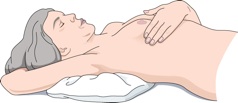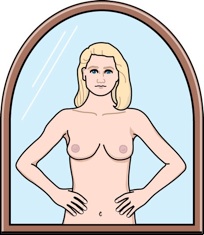Section Two
Playing it Safe
Breast Self-Exam (BSE)
How To Do a BSE
Breast awareness is knowing how your breasts normally look and feel and checking for changes. You can do this while you shower or get dressed. A breast self-exam (BSE) is a step-by-step method to examine your breasts. Beginning at age 20, ask your health care provider about the pros and cons of doing a BSE. If you choose to do a BSE, examine your breasts during times of the month when they are not normally tender or swollen. If you menstruate, the best time may be within 3 days after your period stops.
BSE Steps


-
Lie down. Place a pillow under your right shoulder. Put your right hand behind your head. Move the pads of your left hand’s 3 middle fingers, held flat, in small, circular motions as you start to feel your right breast tissue. Use this circular motion in an up and down pattern as you check the entire breast area. This includes the area from as high up as your collarbone to as low as the ribs below your breast; and from your right side (from under your arm) across the breast to the middle of your chest bone. Feel every part of this entire area with 3 different levels of pressure:
- Light – Feel the tissue closest to the skin.
- Medium – Feel a little deeper than the skin.
- Firm– Feel the tissue closest to your chest and ribs.
- Squeeze the nipple gently. Check for a clear or bloody discharge.
- Repeat steps 1 and 2 for the left breast using the finger pads of your right hand.
-
Stand in front of a mirror. Press your hands firmly on your hips. Look for:
- Any changes in the size, shape, or contour of your breasts.
- Puckering, scaling, or redness of the skin.
- Nipple changes or discharge.
- Sit or stand. Raise your arm slightly. Examine each underarm area for lumps or changes.
If you a find a lump or any change in the way your breasts normally look or feel, let your health care provider know right away. Most lumps that are found and tested are not cancer.
For more information, contact:
The National Cancer Institute | 800.4.CANCER (422.6237) | www.cancer.gov